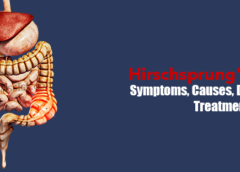Overview
Hirschsprung’s disease (HIRSH-sproongz) is a condition that affects the large intestine (colon) and causes difficulties in passing the stool. The disease occurs at birth (congenital) as a result of losing nerve cells in the baby’s colon muscles.
In the days after birth, a newborn who has Hirschsprung’s disease usually cannot have a bowel movement. The disorder could not be detected in mild cases until later in infancy. Hirschsprung’s disease is uncommonly first diagnosed in adults.
The surgery treatment to bypass or remove the diseased part of the colon.
Symptoms
Hirschsprung’s signs and symptoms differ according to the severity of the disorder. Signs and symptoms typically occur shortly after birth but often they are not apparent until later in life.
Usually, a neonate’s failure to have a bowel movement within 48 hours of birth is the most obvious sign.
In newborns other signs and symptoms may include:
- Swollen belly
- Vomiting, including the vomiting of a green or brown product
- Constipation or gas that may cause newborn chaos
- Diarrhea
In older children, signs and symptoms can include:
- Swollen belly
- Chronic constipation
- Gas
- Failure to thrive
- Fatigue
Causes
It’s not clear what causes Hirschsprung’s disease. It sometimes occurs in families and might, in some cases, be associated with a genetic mutation.
Hirschsprung’s disease occurs when colon nerve cells do not completely develop. Colon nerves handle muscle contractions and push food through the intestines. Stool stays in the large intestine, without the contractions.
Risk factors
Factors which can maximize the risk of Hirschsprung’s disease include:
Having a sibling who has Hirschsprung’s disease: Hirschsprung’s disease can be inherited. Future biological children may be at risk if you have one child who has the disease.
Being male: Hirschsprung’s disease is more common in males.
Having other inherited conditions: Hirschsprung’s disease is attributed to other inherited disorders, such as Down syndrome and other birth-related defects, such as congenital heart disease.
Complications
Children suffering from Hirschsprung’s disease are vulnerable to a severe bowel infection called enter colitis. Enter colitis can present life-threatening conditions and requires immediate treatment.
Diagnosis
Your child’s doctor will do an evaluation and ask questions about bowel movements of your infant. He or she can recommend diagnosing or rule out Hirschsprung’s disease by one or more of the following tests:
Abdominal X-ray using a contrast dye: Barium or other contrast dye is placed inside the intestine by means of a special tube inserted into the rectum. The barium fills and covers the bowel lining, thereby providing a simple colon and rectum outline.
Sometimes, the X-ray reveals a strong difference between the narrow bowel section without nerves and the usual but sometimes swollen bowel section behind it.
Measuring control of the muscles around the rectum (anal manometry). Usually, a manometer test is conducted on older children and adults. Within the rectum, the doctor inflates a balloon. As a result, the corresponding muscle will relax. If not, it may be the cause of Hirschsprung’s disease.
Removing a sample of colon tissue for testing (biopsy). This is the surest way to understand the disease of Hirschsprung. Using a suction system, a biopsy sample can be obtained, then examined under a microscope to determine whether nerve cells are absent.
Treatment
For most cases, Hirschsprung’s disease is surgically managed to bypass the part of the colon that lacks nerve cells. This can be achieved in two ways: a pull-through surgery, or ostomy surgery.
Pull-through surgery
The lining of the diseased part of the colon is stripped off in this process. The normal segment is then taken from the inside via the colon, and added to the anus. This is normally achieved using minimally invasive (laparoscopic) techniques which are working via the anus.
Ostomy surgery
The surgery may be performed in two stages in children who are very sick.
Firstly, the anomalous portion of the colon is removed and the top, healthy portion of the colon is attached to an opening created by the surgeon in the abdomen of the child. Then, through the crack, Stool leaves the body in a bag that sticks to the end of the intestine, which protrudes through the hole in the abdomen. This gives them time to colon’s lower portion for healing.
After the colon has time to recover, another operation is performed to close the stoma and attach the healthy part of the intestine to the rectum or anus.
Results of surgery
Most kids are able to move stool via anus after surgery.
Possible complications that may improve with time include:
- Diarrhea
- Constipation
- Leaking stool (faecal incontinence)
- Delays in toilet training
Children may remain at risk of developing a bowel infection (enterocolitis) following surgery, particularly during the first year. If any of the signs and symptoms of enterocolitis occur, call your doctor immediately, like:
- Bleeding from the rectum
- Diarrhea
- Fever
- Swollen abdomen
- Vomiting

Leave a Reply
You must be logged in to post a comment.